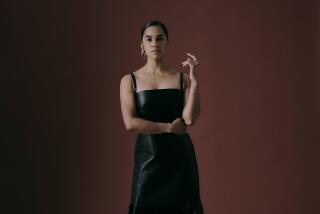Moira Shearer, 80; Ballerina, Actress Starred in the 1948 Hit Film ‘The Red Shoes’
- Share via
Moira Shearer, the flame-haired ballerina-turned-actress who became an international star in “The Red Shoes,” a poetic and sensual film that inspired generations of young dancers, died Tuesday at a hospital in Oxford, England. No cause of death was reported. She was 80.
Using Technicolor photography, “The Red Shoes” (1948) was one of the most stunning films of its vintage, and its entrancing, porcelain-skinned heroine was credited with almost single-handedly popularizing ballet for millions. However, in later years she disparaged the film and its cost to her ballet career, saying, “Isn’t it strange that something you’ve never really wanted to do turns out to be the very thing that’s given you a name and identity?”
Moira Shearer King was born in Dunfermline, Scotland, on Jan. 17, 1926. Her father, a civil engineer, moved the family to Northern Rhodesia (now Zambia), where she was pushed into dance lessons by her mother.
She called her upbringing strict and provincial, lightened only by her parents’ knowledge of music, which she cherished.
After the family returned to Scotland, she received lessons from Nikolai Legat, the Russian master who had trained Anna Pavlova and Vaslav Nijinsky, as well as from Legat’s widow.
Ninette de Valois, the founder of the prestigious Sadler’s Wells Ballet, made Shearer a principal dancer with her organization. In 1946, she danced “Swan Lake” as Odette and Odile and “The Sleeping Beauty” as Princess Aurora. Also that year, she was in Frederick Ashton’s “Symphonic Variations,” her red hair providing vibrant contrast when she appeared onstage with blond Pamela May and brunet Margot Fonteyn.
In 1948, Shearer replaced an ailing Fonteyn in “Cinderella” and triumphed in another Ashton piece, the abstract “Scenes de Ballet,” performed with a Stravinsky score.
Her critical reputation soared, not least because of “The Red Shoes,” which she had rejected as “silly and banal” when shown the script.
Directors Michael Powell and Emeric Pressburger based “The Red Shoes” on a Hans Christian Andersen fairy tale about a young girl entranced by magical ruby-red shoes. Their film was set in the ballet world, with a young ballerina forced to channel all her passion into her career.
Also featured was a full-length ballet of “The Red Shoes” with dancer-choreographer Robert Helpmann.
Almost universally glowing reviews assured the film status as an instant classic, and critic Bosley Crowther wrote in the New York Times that Shearer “is amazingly accomplished and full of a warm and radiant charm.”
But Shearer regarded filming as an unhappy experience and said Powell had a “total coldness and inhumanity” on the set. She was displeased with her acting and dancing and uncomfortable being promoted as the greatest dancing find of her generation.
“ ‘The Red Shoes’ ruined my career in the ballet.” Her peers “never trusted me again,” she told a Glasgow reporter in 1994.
Soon after “The Red Shoes,” she made a celebrated North American tour with Sadler’s Wells, and choreographer George Balanchine cast her in his “Ballet Imperial” (1950). She later wrote a generous book about Balanchine.
In 1954, Shearer quit ballet but made sporadic film appearances, including two more for Powell: “The Tales of Hoffmann” (1951) and the thriller “Peeping Tom” (1960). She also was in “Black Tights” (1960), teaming with Roland Petit to dance “Cyrano de Bergerac.”
She rounded out her career performing in stage works by Anton Chekhov, Noel Coward and others.
In 1950, she married writer and broadcaster Ludovic Kennedy.
Survivors include her husband and four children.
More to Read
Only good movies
Get the Indie Focus newsletter, Mark Olsen's weekly guide to the world of cinema.
You may occasionally receive promotional content from the Los Angeles Times.










